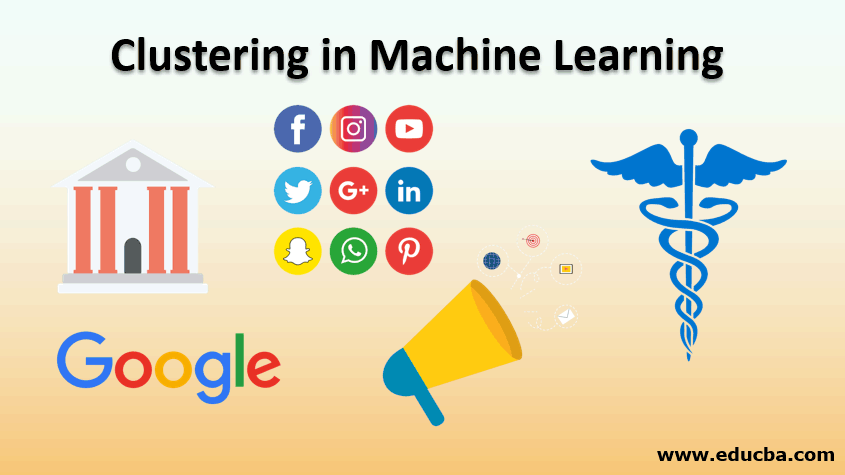Updated March 21, 2023

Introduction to Clustering in Machine Learning
Clustering in Machine Learning is one of the main method used in the unsupervised learning technique for statistical data analysis by classifying population or data points of the given dataset into several groups based upon the similar features or properties, while the datapoint in the different group poses the highly dissimilar property or feature. The clustering methods used in machine learning (i.e., k-mean clustering, Density methods, Grid-based methods, Hierarchical bases method, etc.) perform the data points’ collection based upon the similarity and dissimilarity between them.
How does Clustering Work in Machine Learning?
In clustering, we group an unlabeled data set, which is known as unsupervised learning. When we first group unlabeled data, we need to find a similar group. When we create a group, we need to understand the features of datasets, i.e., similar things. If we create a group by one or two features, it is easy to measure similarity.
- Example #1: Movies by the director. Once clustering is done, each cluster is assigned a cluster number which is known as ClusterID. Machine learning system like YouTube uses clusterID to represent complex data most easily.
- Example #2: YouTube uses our search history or watched history and suggests videos we might like. Facebook’s feature data contains people we follow, pages we follow, comments we input, photos or videos we like, pictures or photos we tag at. Clustering Facebook video or photo will replace a set of features with a single clusterID due to the compressing of data.
Top 4 Methods of Clustering in Machine Learning
Below are the methods of Clustering in Machine Learning:
1. Hierarchical
The name clustering defines a way of working; this method forms a cluster in a hierarchal way. The new cluster is formed using a previously formed structure. We need to understand the differences between the Divisive approach vs Agglomerative approach. Agglomerative is a bottom-up approach; it starts with individual points in a cluster and combines some arbitrary. Divisive begins with a single cluster, all points in a cluster and divides it into multiple clusters.
2. Density-Based
In this method, a dense region is considered as a cluster who’s having some similarities. It is different from the lower dense region of the object space. DBSCAN is known as the Density-based spatial clustering of applications with noise. DBSCAN looks for some epsilon for data object-orientation; we set some radius epsilon and the minimum number of points. If we surpass some minimum number of points within a radius, then we rank a cluster high density. So, this way, we can consider data with a region of high density. DBSCAN differs from the centroid method of clustering as it is not a strict approach. Noise points are points in low-density areas that are left unlabelled or labeled as outliers. That’s the reason we don’t require specific K. We can specify minimum points for high-density region and radius we want for a region to be or clusters to be.
3. Partitioning
When we have a dataset of N number of objects, this method constructs “K” as the partition of data. This partition is the cluster, i.e. construct K, partition (K<=N).
Requirements to be Met:
- Each group or dataset must contain at least one object.
- Each object should belong to one group only.
One of the examples of partitioning is K-means clustering.
4. Grid-Based
Object space, a finite number of cells, forms a grid structure. This method provides fast cluster processing. These are independent of object space.
Applications of Clustering in Machine Learning
Below are the applications of Clustering in Machine Learning:

1. Medical
The doctor can use a clustering algorithm to find the detection of disease. Let’s take the example of thyroid disease. The thyroid disease dataset can be identified using a clustering algorithm when we apply unsupervised learning on a dataset containing a thyroid and non-thyroid dataset. Clustering will identify the cause of the disease and will give a successful result search.
2. Social Network
We are the generation of the internet era; we can meet any person or got to know about any individual identity through the internet. Social networking sites use clustering for content understanding, people face or the location of the user. When unsupervised learning is used in social, it is useful for the translation of language. For example, Instagram and Facebook provide the feature of translation of language.

3. Marketing
We can see or observe that different technology is growing beside us, and people are attracting to use those technologies like cloud, digital marketing. To attract a greater number of customers, every company is developing easy to use features and technology. To understand the customer, we can use clustering. Clustering will help the company to understand the user segment and then categorize each customer. This way, we can understand the customer and find similarities between customers and group them.

4. Banking
We have observed that fraud of money is happening around us, and the company is warning customers about it. With the help of clustering, insurance companies can find fraud, acknowledge customers about it and understand policies brought by the customer.

5. Google
Google is one of the search engine people uses. Let’s take an example when we search for some information like pet stores in the area; Google will provide us with different options. This is the result of clustering, clustering of similar results that is provided to you.
Conclusion
We have seen about clustering and machine learning. Way of clustering works in machine learning. Information about unsupervised learning. The real-time usage of unsupervised learning. Methods of clustering and how each method works in machine learning.
Recommended Articles
This is a guide to Clustering in Machine Learning. Here we discuss the top 4 methods of clustering in machine learning along with applications. You can also go through our other related articles to learn more –

